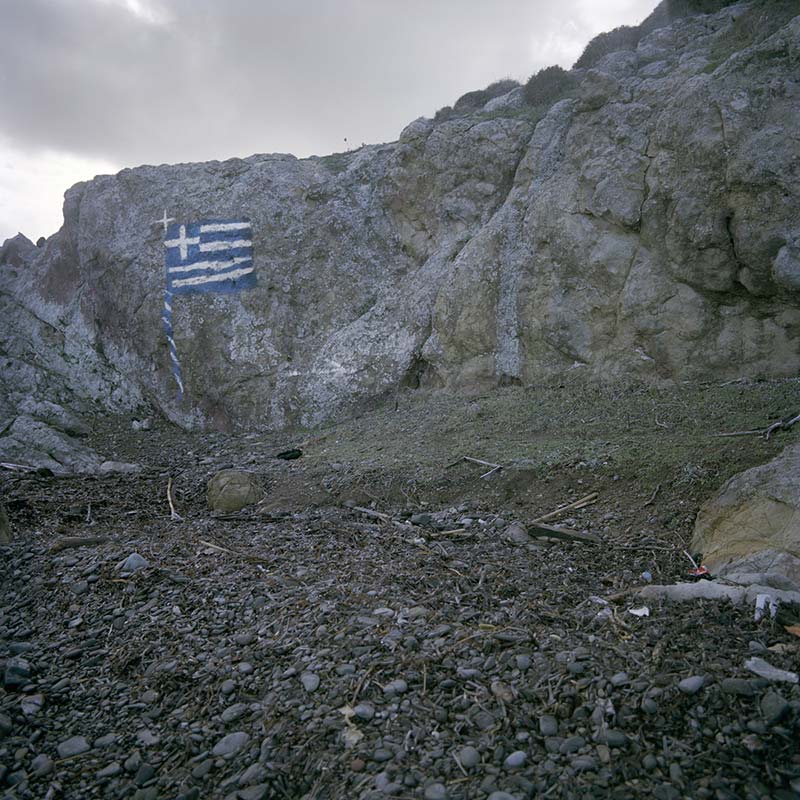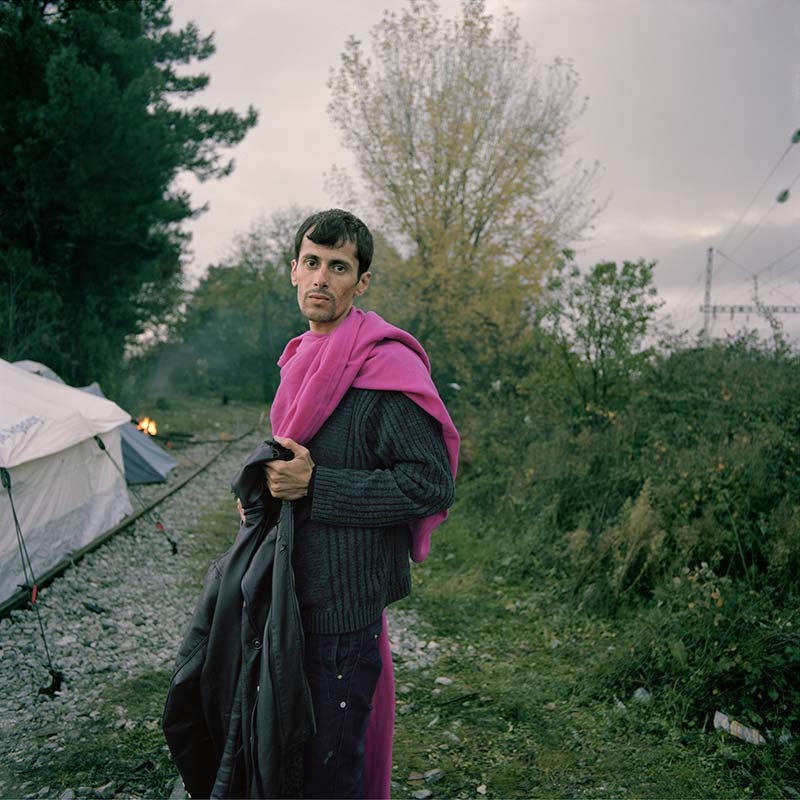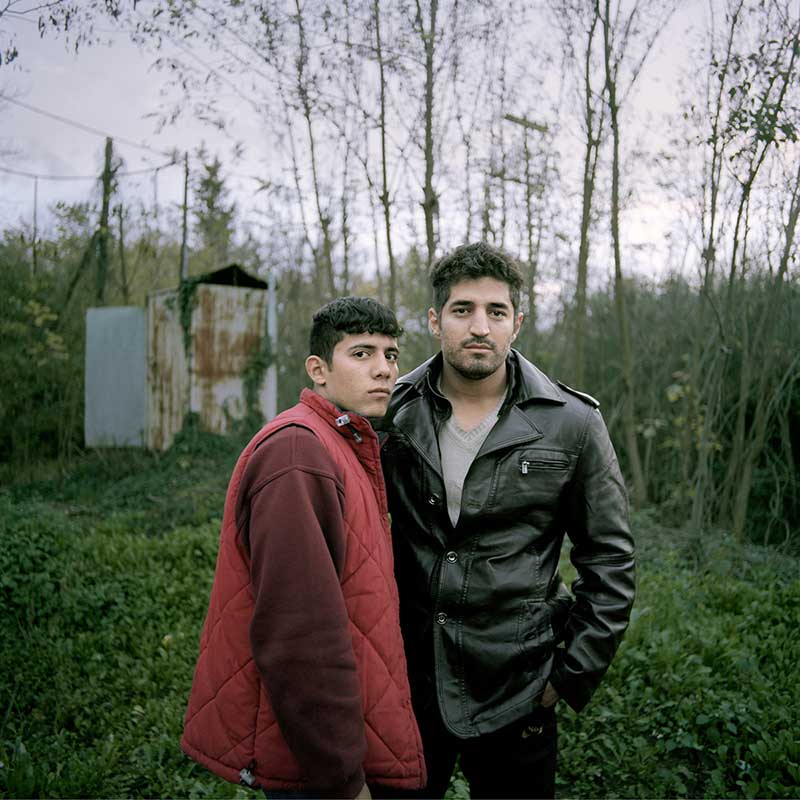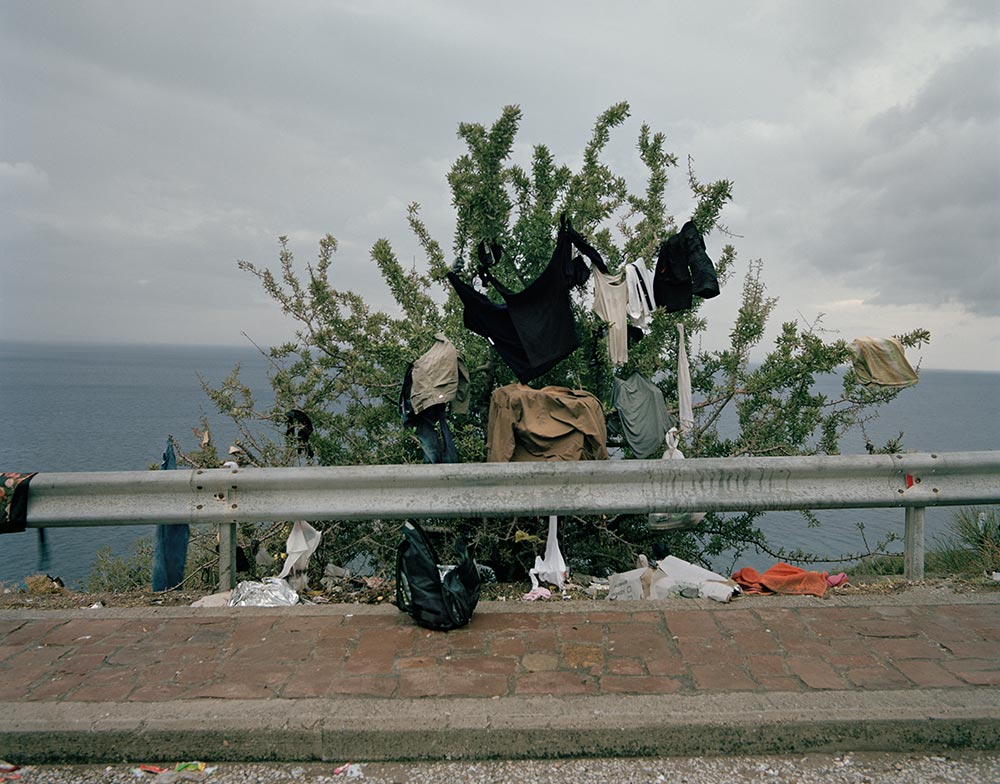INTERVIEW
Photography in a Post-Truth World
WITH DEMETRIS KOILALOUS
An interview with Demetris Koilalous
“I believe that in the ‘post-Truth’ era we are also entering a new age in the arts, where the political and the personal/the existential need to be reconsidered”.
Demetris Koilalous was selected as the winner of our ‘Still Life’ theme with an image described by judge Lorenzo Vitturi as “quintessentially contemporary: aesthetically, the ‘still life’ turns into an installation in a ‘natural’ environment, whilst conceptually it serves as a metaphor to approach a problematic social issue, emblematic of today’s society”.
That image comes from his series ‘Caesura: The Duration of a Sigh’ – a collection of photographs exploring the transitory state of migrants entering Greece after crossing the Aegean Sea, or infamous ‘Death Passage’. The title comes from the musical term, denoting a brief pause of silence in the middle of a musical phrase, in this context used as a metaphor to describe the intemporality he explores – the moment following a distressing journey, and ahead of a new life in unknown lands.
Fittingly, his images hold power in their serenity – far from the chaos of boat trips and beach landings, of refugee camps and holding pens, his images reflect on the individuals caught up in this mass upheaval. They show distinct identities and recognisable faces of fellow people, pausing in a temporary landscape before continuing their journeys onwards.
We asked Demetris more about ‘Caesura’, while exploring his background and approach. The resulting interview is one of the most insightful and thoughtful conversations we have had with our community of photographers, and we invite you to share in it.
Tell us about your background. How did you get into taking pictures and when did you choose this medium as a career?
I started photographing as a student in Edinburgh. In a way photography was just a tool – making records for our Town and Country planning projects. This was in the early 80’s. Towards the end of the 80’s I started shooting theatrical plays and as soon as I came back to Greece in 1990, I decided to take it up professionally.
You’ve been working with both advertising companies and cultural institutions – quite disparate types of organisation. How do those two practises differ? And equally, how do they influence each other?
I believe that as long as one understands the different needs and the different language involved in each practice, then in a way there isn’t much difference. Obviously the ‘ethics’ and the ‘politics’ are indeed very different between the two, but still the organisation is similar and the basic idea remains the same: to visually articulate a set of ideas and concepts. I believe that both require a high level of dexterity at the technical as well as the mental level. As far as my photography is concerned I think that each of the two genres has helped the other to develop and become more sophisticated and analytical.




You won the “Still Life” theme of the current LF edition, judged by Lorenzo Vitturi, with an image from your most recent series “Caesura – the duration of a sigh”. The series portrays migrants entering Greece after crossing the Aegean Sea, both through portraits of them in their newfound living conditions but also through their personal belongings. The winning image – far from the traditional concerns of still life – explores metaphorically the issues of identity for refugees and migrants.
Indeed as Lorenzo Vitturi pointed out, it resembles to a strange kind of installation. This is how it felt when I saw it by the side of the road. It was almost surreal, yet full of meaning; those colourful cloths which belonged to different people of different origins and cultures, looked like a flock of migratory birds resting on the tree, before they continued their journey. This was my initial thought. During the first months when there were very few volunteers and very limited supplies –only what the locals generously gave away- one of the biggest problems was lack of food and wet clothes. In this sense this tree was literally a tree of hope; a tree loaded with gifts…like a Christmas tree.
Tell us more about the project, how did you approach it? And what led you down this approach, rather than a purely photojournalistic one?
Photojournalism does not interest me in the least. I think that it uses a photographic language which is very obvious, exaggerated and excessive -and to my eye a little kitsch. Also, I believe that it is a language which is supposed to say “how ‘things’ are / how ‘things’ happened”, in other words to give ready answers to the viewer without requiring ANY involvement whatsoever. In a way, ‘frontline’ photography is impressive and possibly this is why it is still appealing despite the existence of video; however my approach is different altogether. I prefer to be a little ambiguous and neutral and make the viewer participate and think. I don’t like to give away photographs which have a simple and univocal meaning. When I photograph I think a lot; before I make the photograph and after I make the photograph, and I want this state of mind to reach the viewer. I think that this is more dialectic and democratic.
In each portrait, the scenery seems as important as the subject – even in portraits where background tells a lot about the photograph itself. It could be said that the backgrounds act as a record of the relation between the migrants and their changing environment.
From the beginning of the project my intention was to disengage the people from the surrounding ‘action’. This was very difficult because most of the time the conditions were literally chaotic. Even in cases where the background appears to be a wide empty field and there is a feeling of desolation and solitude, there are hundreds of people wandering around. So, in many (most) cases the scenery is deceiving (but photography is deceiving anyway isnt it?). I usually consider the background as a theatrical setting, rather than a realistic context. In most cases I had already a background in my mind and then I redirected the movement to this particular ‘setting’. Therefore both at the aesthetic and the conceptual levels, the background space and the people are intentionally interrelated more at a conceptual level. Obviously they are physically related anyway, since those people lived and moved in that very environment. However in my photographs my intention was to shift emphasis from the ‘physical space’ towards the ‘psychological space’.




Can you tell us a little bit about your process when making portraits? How would you work with the subjects, and how would you select the background?
Like in Theatre, the background has an autonomy as a picture; it functions as a theatrical set. In Ancient Greek tragedy there was a main central space/set and then there were two byroads/entrances which symbolized the entrance from the city or the exit to the countryside; so a setting is always a highly organized and hierarchical space: first you enter and then you exit. A ‘theatrical set’ is an integrated and balanced environment, which usually bears the characteristics and the elements that I want to feature and emphasize.
Then I keep it in my mind, in order to use it at a later time – it is like doing a repérage for cinema. Usually i get to know the people before I photograph them. I was very much interested in their stories. I sat with them, I stayed with them –often for a few days. We ate together, we talked, saw each other again and again in the course of their short stay. Many times it was their face that attracted me, some other times it was what they were holding, and what they told me.. But –in a strange way- most of the photographs that I kept after the final selection, were of people who actually ‘came to me’ by themselves. People who wanted to see who I was, what I was doing and why. So, in a way they were people who chose to ‘share’ themselves with me.
Another specificity of your aesthetic is the square format. Why did you choose this and what does it bring to your work?
Initially I had chosen to photograph in 4X5 format with a view camera. However this was a difficult and very slow procedure for the specific subject. I started photographing in the islands of Lesvos and Chios where people came ashore in a shocking rhythm, with incredible tension, so the idea of the view camera was overruled. I decided to shoot with a camera that was not handheld and I ended up using a traditional 6X6 studio camera, always on a tripod. It was a little funny to walk around with a heavy-duty tripod and a flash meter hanging from my neck. However, this ‘look’ allowed me to photograph people who were very sceptical about being recorded (especially some left wing political refugees from Iran) or women in traditional families who are usually quite strict about exposure in the media, etc. Probably the surrealistic look and the slow speed which I had, even the use of a remote release, inspired some kind of trust in me and the medium, which is also evident in the photographs. People had to stop, they had to pose, etc. I never caught them on the move. Many times we would even walk together further away; so the choice of this format also eliminated all spontaneity -which helped me to go to the direction I wanted. Regarding the aesthetics of both the 4X5 and the square format which I finally used, I think that when you work with a tripod almost everything looks well-weighted and geometrical albeit a little formalized.




Finally, as the refugees’ crisis topic seems to come up more and more in relation to creative work – in your mind, what’s the role of the artist/photographer when it comes to politics?
In conversations that I had with people in local communities I would point out that without the photographers and the photo-journalists, very few people would have known about this crisis, therefore in a way they owed the arrival of volunteers to the photographers who exposed the issue. However, this is not exactly politics. Literally and politically speaking politics does not only relate to action or activism. It should also raise political consciousness. It should talk about ideology, relations of power etc; most of all it should induce political connotations. In this sense simply exposing a problem -as photo reportage does- is not political per se, because as an approach it does not provide a political stimulus; in fact it even may function in the wrong direction.
I remember one great interview by the British actor and activist Stephen Fry who said that one of the common practices of Fascism and Nazism was to deliberately dehumanize minorities by naming them ‘worms’, ‘cockroaches’, ‘bitches’, ‘dogs’ etc in order to legitimize violence against them and reduce guilt when this violence was exerted on them. This is a very important remark because it is very similar to what happens today, 70 years after the Holocaust -with different and apparently completely innocent intentions! Introducing this huge crowd of people as a nameless crowd, like a flock of people busting in the ‘western world’, without any control (a view widely shared by the media), is an approach which in fact dehumanizes the individuals involved, putting on people the anonymous and generic mask of the MIGRANT or the REFUGEE.
So my answer is that there is great political meaning in photography but the photographer must be very certain and very conscious of what this meaning may be, because it is just as easy to ‘go’ in the wrong direction and instead of alertness it may easily cause aversion.
Especially nowadays photographers must be very cautious because they handle a notion which is very sensitive and political: Truth. The artist must rethink: WHAT IS TRUTH? Is truth something that you can simply verify with your own eyes or is it something, which also requires analysis and dialectic insight? I believe that in the ‘post-Truth’ era we are also entering a new age in the arts, where the political and the personal/the existential need to be reconsidered.
All images and text © Demetris Koilalous
See more of his work at www.demetriskoilalous.com
